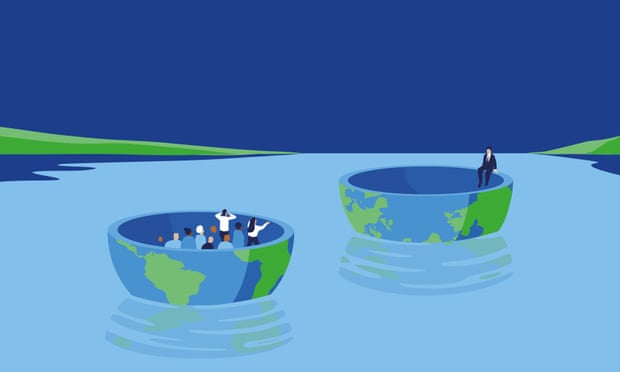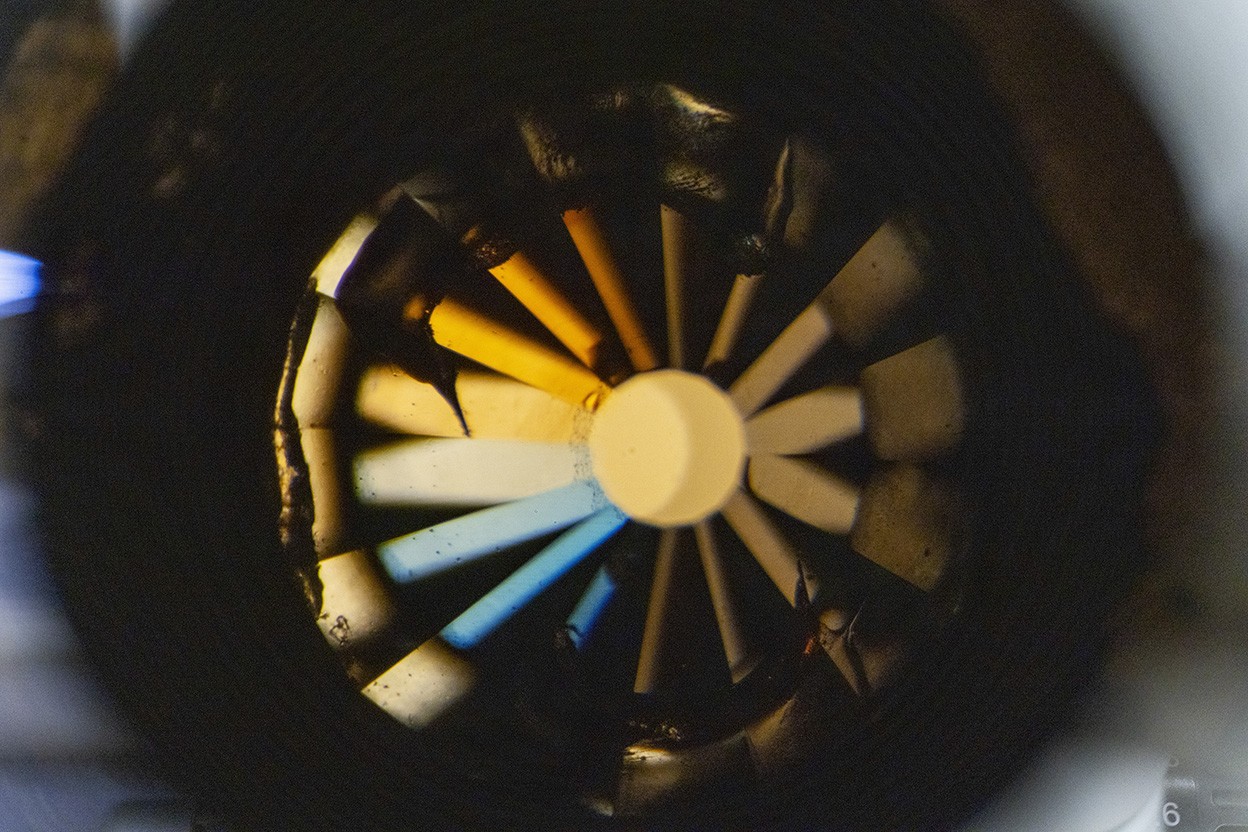


At the beginning of each year, the world’s corporate and political elite gather in the Swiss ski resort of Davos to pat each other on the back, attend seminars on “the fourth Industrial Revolution” – whatever that might be – and generally mull over the state of the world. Rarely is so much wealth to be found in so few conference rooms. And each year, Oxfam, the global development charity, takes the opportunity to run the numbers on the state of global inequality. Oxfam’s findings are often eye-catching, but this year especially so.
The wealth of the five richest people in the world, they found, has more than doubled, from $405bn (£320bn) in 2020 to $869bn in late 2023. That’s an increase of about $14m an hour, which is not bad going by anyone’s reckoning. Perhaps more strikingly, Oxfam calculates that on current trends the world is due to welcome its first dollar trillionaire within a decade. Elon Musk, the richest person at the time of writing, is worth about a fifth of that, at $210bn.
It may of course take longer than Oxfam predicts, but the global trends are reasonably clear. Go back a decade or so, and the world’s then richest man, Carlos Slim – a Mexican telecoms magnate – was worth about $70bn, or one-third of Musk’s current estimated value. It does seem likely that, without a radical change, we’ll have our first trillionaire by the 2040s.
Even in macroeconomics, where huge numbers are commonplace, a trillion dollars is a big deal. For context, the entire annual economic output of the United Kingdom comes in at about $2.9tn. To grasp how unprecedented it will be, it’s helpful to think historically. The oil magnate John D Rockefeller was announced by newspapers as the world’s first dollar billionaire back in 1916. US GDP was around $50bn then, so Rockefeller was worth about 2% of national income. Now it’s closer to $27tn and expected to grow to $40tn by the mid-2030s, so a contemporary trillionaire would be worth between 2.5% and 3.5% of the output of the world’s richest country – a larger chunk than the wealthiest person in modern economic history.
Read the rest of this article at: The Guardian
In 2020, Ranga Dias was an up-and-coming star of the physics world. A researcher at the University of Rochester in New York, Dias achieved widespread recognition for his claim to have discovered the first room-temperature superconductor, a material that conducts electricity without resistance at ambient temperatures. Dias published that finding in a landmark Nature paper1.
Nearly two years later, that paper was retracted. But not long after, Dias announced an even bigger result, also published in Nature: another room-temperature superconductor2. Unlike the previous material, the latest one supposedly worked at relatively modest pressures, raising the enticing possibility of applications such as superconducting magnets for medical imaging and powerful computer chips.
Most superconductors operate at extremely low temperatures, below 77 kelvin (−196 °C). So achieving superconductivity at room temperature (about 293 K, or 20 °C) would be a “remarkable phenomenon”, says Peter Armitage, a condensed-matter researcher at Johns Hopkins University in Baltimore, Maryland.
But Dias is now infamous for the scandal that surrounds his work. Nature has since retracted his second paper2 and many other research groups have tried and failed to replicate Dias’s superconductivity results. Some researchers say the debacle has caused serious harm. The scandal “has damaged careers of young scientists — either in the field, or thinking to go into the field”, says Paul Canfield, a physicist at Iowa State University in Ames.
Previous reporting by The Wall Street Journal, Science and Nature’s news team has documented allegations that Dias manipulated data, plagiarized substantial portions of his thesis and attempted to obstruct the investigation of another paper by fabricating data.
Three previous investigations into Dias’s superconductivity work by the University of Rochester did not find evidence of misconduct. But last summer, the university launched a fourth investigation, led by experts external to the university. In August 2023, Dias was stripped of his students and laboratories. That fourth investigation is now complete and, according to a university spokesperson, the external experts confirmed that there were “data reliability concerns” in Dias’s papers.
Now, Nature’s news team reveals new details about how the scandal unfolded.
Read the rest of this article at: Nature
Economics has achieved much; there are large bodies of often-nonobvious theoretical understandings and of careful and sometimes-compelling empirical evidence. The profession knows and understands many things. Yet today we are in some disarray. We did not collectively predict the financial crisis and, worse still, we may have contributed to it through an overenthusiastic belief in the efficacy of markets, especially financial markets whose structure and implications we understood less well than we thought. Recent macroeconomic events, admittedly unusual, have seen quarreling experts whose main point of agreement is the incorrectness of others. Economics Nobel Prize winners have been known to denounce each other’s work at the ceremonies in Stockholm, much to the consternation of those laureates in the sciences who believe that prizes are given for getting things right.
Read the rest of this article at: The Chronicle of Higher Education
The first thing you notice when walking into the middle-school classrooms at Brilla, a charter-school network in the South Bronx, is the sense of calm. No phones are out. The students are quiet—not in the beaten-down way of those under authoritarian rule but in the way of those who seem genuinely interested in their work. Sixth graders participate in a multiday art project after studying great painters such as Matisse. Seventh graders prepare to debate whether parents should be punished for the crimes of their minor children. Another group of sixth graders, each holding a violin or a cello, read out notes from sheet music. A teacher cues them to play the lines pizzicato, and they pluck their strings in unison.
Brilla is part of the classical-education movement, a fast-growing effort to fundamentally reorient schooling in America. Classical schools offer a traditional liberal-arts education, often focussing on the Western canon and the study of citizenship. The classical approach, which prioritizes some ways of teaching that have been around for more than two thousand years, is radically different from that of public schools, where what kids learn—and how they learn it—varies wildly by district, school, and even classroom.
In many public schools, kids learn to read by guessing words using context clues, rather than by decoding the sounds of letters. In most classical schools, phonics reign, and students learn grammar by diagramming sentences. Some public schools have moved away from techniques like memorization, which education scholars knock as “rote learning” or “drill and kill”—the thing that’s killed being a child’s desire to learn. In contrast, classical schools prize memory work, asking students to internalize math formulas and recite poems. And then there’s literature: one New York City public-high-school reading list includes graphic novels, Michelle Obama’s memoir, and a coming-of-age book about identity featuring characters named Aristotle and Dante. In classical schools, high-school students read Aristotle and Dante.
Classical education has historically been promoted by religious institutions and expensive prep schools. (Many classical schools have adopted the Harkness method, pioneered by Phillips Exeter Academy, in which students and teachers collectively work through material via open discussion.) More recently, powerful investors have seen its potential for cultivating academic excellence in underserved populations: the Charter School Growth Fund, a nonprofit whose investors include the Bill & Melinda Gates Foundation and Bloomberg Philanthropies, has put millions of dollars into classical schools and networks.
Read the rest of this article at: The New Yorker
The deep has long been treated as somehow separate from the surface world, a shadowy non-place populated by alien creatures. While this is partly a response to the difficulty of studying it, it also reflects an ingrained tendency. As the writer Robert Macfarlane has observed, humans are creatures of the air and light, and we have often regarded the spaces beneath our feet with abhorrence, associating them with death, entombment and the unseen and unnameable. And while what Macfarlane calls the underland might be a place of ritual power as well as a place of burial, the ocean’s depths are more frequently equated with loss and forgetting.
Although those versed in traditional wayfinding techniques often understood the ocean in more complex ways, the idea of the deep as an unknowable non-place was also embedded in navigational practices. For European sailors plying the waters of the Mediterranean sea and the Atlantic and Indian oceans, all that really mattered was knowing where potential obstacles and risks such as reefs and sandbars lay – a way of thinking that transformed the ocean’s depths into a blank irrelevance.
It was not until the early 19th century that a more detailed scientific understanding of the deep began to take shape. In part, this was a result of the growing reach of the colonial powers: as the commercial and territorial aspirations of Europeans and Americans expanded to encompass the globe, the need for more accurate and more detailed knowledge of the ocean grew as well. But it also grew out of the experiences of whalers, whose voyages were now taking them far out into the open waters of the Atlantic and Pacific, and leading to an appreciation of the great depths to which whales would often dive.
This interest in the deep ocean took on a new urgency in the 1850s, when British and American entrepreneurs began to lay the first submarine telegraph cables across the Atlantic. The technical challenges of these ventures demanded a more detailed understanding of the ocean floor. But it was not until the Challenger expedition circumnavigated the globe on its pioneering scientific survey of the world’s oceans in the 1870s that the true extent of the deep ocean finally started to emerge. In the north-west Pacific, where the Mariana Trench plunges downwards into the planet’s crust, HMS Challenger recorded depths in excess of 8,000 metres. Perhaps even more startling to the scientists of the day, though, was Challenger’s discovery of tiny shells – and therefore living things – more than 7,000 metres down.
Across the century and a half since the Challenger expedition, our understanding of life in the depths has offered many surprises. One of the most important of these involves the existence of thriving communities of living things clustered around hydrothermal vents in the ocean floor. These vents form where cracks in the Earth’s crust allow seawater to come into contact with liquid magma. At the surface, water exposed to magma would simply boil away, but deep below the surface, the pressure prevents this. Instead, the water is expelled back into the ocean in a superheated geyser. These jets can exceed 400C, and bear a stream of minerals upwards from the Earth’s mantle. As the water cools, these minerals solidify, forming structures that can be dozens of metres high and can grow as much as 30cm a day.
Read the rest of this article at: The Guardian






